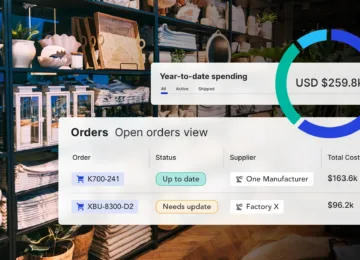Whether you’re a small startup or a global corporation, the purchase order (PO) process plays a pivotal role in your operations. But how can you tell if your purchase order process is as efficient as it should be?
In this blog, we’ll delve into the intricacies of purchase order management and highlight three telltale signs that your current process may be falling short. From bottlenecks that slow down your procurement to missed cost-saving opportunities, we’ll explore the common pitfalls that could be undermining your business’ potential.
By identifying these signs, you’ll be better equipped to streamline your purchase order process and pave the way for greater productivity and profitability. Read on to discover the three key signs that your purchase order process may not be as efficient as it could be, and learn how to take steps toward enhancement.
Sign #1: You’re Stuck Using Manual Processes
67% of supply chain managers still use Excel to manage aspects of their supply chain.
In the age of digital transformation, a reliance on manual processes can be a glaring indicator that your purchase order system is in need of an overhaul. While there was a time when pen-and-paper methods were the norm, today, these antiquated practices can slow your business down and leave it vulnerable to costly errors and inefficiencies.
As Flieber CEO Fabricio Miranda recently explained, manual processes like spreadsheets are an “illusion of control”. Because you feel like you’re in control when conducting work manually, you feel like you’re making better decisions. But this isn’t the case, especially when you consider the complexity of today’s supply chain and PO process.
There are many pitfalls to using manual methods throughout the purchase order process. These include:
- Time-Consuming Data Entry: One of the most apparent drawbacks of manual purchase orders is the laborious data entry involved. Transcribing product information, quantities, and pricing from paper documents into digital systems is not only time-consuming but also highly susceptible to human error. This can lead to discrepancies, delays, and frustrated employees.
- Limited Visibility: In a manual process, tracking the status of purchase orders can be akin to searching for a needle in a haystack. With no centralized system in place, it becomes challenging to monitor where each order is in the procurement pipeline. This lack of visibility can result in missed deadlines, stockouts, and miscommunication with suppliers.
- Risk of Duplication: Without automated checks and balances, it can be easy for employees to accidentally create duplicate purchase orders. These duplicates can lead to over-ordering, overstocking, and unnecessary costs that can impact your company’s profitability.
- Inefficient Approval Workflows: Manual processes often involve the physical movement of paperwork between departments for approvals. This not only wastes valuable time but also increases the chances of documents getting lost or delayed, further hindering the purchase order cycle.
The Path to Efficiency: Automation
The solution to an efficient PO process is automation. Modern purchase order software solutions offer a range of benefits, from streamlining data entry through easy-to-use templates to providing real-time visibility into the status of every order. Automation also allows for customizable approval workflows that can speed up decision-making and reduce bottlenecks.
Automation frees teams from the shackles of manual processes, allowing employees to redirect their energy toward strategic tasks, supplier relationship management, and cost-saving initiatives.
Sign #2: Your Supplier Relationships Are Siloed
A well-structured supplier network is the lifeblood of any successful business. However, if your supplier relationships are siloed and fragmented, it’s a clear indication that your purchase order process may be lacking the cohesion needed to drive efficiency and cost savings.
For example, you may be struggling to collaborate effectively with your supplier base. An inefficient purchase order process can contribute to this, as it often leads to miscommunications, delays, and frustration for both parties. Suppliers may struggle to decipher incomplete or inaccurate purchase orders, leading to errors in product delivery or pricing.
These issues can erode trust and strain relationships, potentially causing suppliers to prioritize more efficient clients. Inefficiency can also hinder the ability to negotiate favorable terms or discounts, reducing the mutual benefits of collaboration.
How to Unlock Better Collaboration: Centralized Supplier Management
By centralizing your supplier relationships, you can address the issue of siloed partnerships. This can be achieved by integrating a purchase order management solution into your tech stack. This is because PO management solutions enable:
- Streamlined Communication: Centralized systems allow for unified communication channels with suppliers. This ensures that everyone involved in the procurement process has access to the same information, reducing misunderstandings and facilitating smoother interactions.
- Consistent Terms and Agreements: With a centralized repository for contracts and agreements, you can enforce uniform terms and conditions across all interactions with suppliers. This consistency not only reduces risk but also simplifies auditing and compliance efforts.
- Data-Driven Supplier Evaluation: A centralized system collects and analyzes data on supplier performance, enabling you to make informed decisions. You can identify top-performing suppliers, negotiate better deals, and weed out underperforming ones, ultimately driving cost savings and improving quality.
- Leveraged Purchasing Power: Centralized supplier management empowers you to consolidate your purchasing power. By aggregating your procurement needs, you can negotiate bulk discounts, rebates, or favorable payment terms that benefit your organization as a whole.
Sign #3: You’re Constantly Under the Wrath of Delayed Shipments
Delayed shipments can be more than just a minor inconvenience; they can be a glaring symptom of an inefficient purchase order process. When your supply chain is plagued by persistent delays, it’s a clear indication that your procurement operations are not performing optimally.
For example, manual data entry errors can lead to discrepancies, incorrect product quantities, or pricing errors. Suppliers may need to clarify or correct these errors, causing delays in order processing. Similarly, poor communication between the purchasing department and suppliers can also result in misunderstandings, missed deadlines, and unanticipated delays. Other features of an inefficient purchase order process, which can cause delays, include:
- Approval Bottlenecks: Delays can occur when purchase orders are stuck in lengthy approval workflows. If there’s no streamlined approval process in place, it can take an excessive amount of time for orders to receive the necessary approvals before they can be transmitted to suppliers.
- Poor Supplier Performance: Inefficient suppliers or those prone to production or logistical issues may frequently cause delays in shipments. If suppliers are unreliable or consistently miss delivery deadlines, this can impact your ability to fulfill orders on time.
- Lack of Real-Time Visibility: Without real-time visibility into the status of purchase orders and shipments, it’s challenging to react swiftly to any deviations from the expected timeline. Delays may go unnoticed until it’s too late to take corrective action.
- Supplier Capacity Issues: Suppliers may experience capacity constraints or production delays due to unforeseen circumstances, such as equipment breakdowns, labor shortages, or natural disasters. These external factors can disrupt supply chains and result in delayed shipments.
Build Towards Efficiency: Streamline Your Procurement Process
Delayed shipments can disrupt your entire production or sales process, causing backlogs, missed deadlines, and unhappy customers. To combat this problem, it’s essential to streamline your purchase order process. Here are key steps you can take:
- Improve Forecasting: Enhance demand forecasting to provide suppliers with more precise order quantities and schedules. This enables suppliers to plan their production and allocate resources more efficiently, ensuring that products are ready for shipment as per the agreed-upon timelines. Additionally, improved demand forecasting helps organizations avoid last-minute rush orders or changes to purchase orders, which can disrupt supplier schedules and lead to delays.
- Increase Real-Time Visibility: Implement systems that offer real-time visibility into the movement of goods across your supply chain. This allows you to identify potential delays early and take proactive measures to mitigate them, such as finding alternative suppliers or shipping methods.
- Leverage Automated Alerts: Set up automated alerts for critical milestones in the purchase order process, such as order confirmation, shipment, and delivery. These alerts can help you stay informed and react promptly to any deviations from the expected timeline.
- Optimize Performance Tracking: Continuously monitor supplier performance metrics, including on-time delivery rates and lead times. Hold suppliers accountable for their performance, and work collaboratively to address issues and improve efficiency.
Creating a More Efficient PO Process With Anvyl
Anvyl’s intelligent PO management platform is an all-in-one platform that empowers organizations to seamlessly manage the entire purchase order process — from PO issuance to delivery in the warehouse.
Our robust platform empowers businesses to overcome the manual and error-prone aspects of their PO processes by offering streamlined data entry, centralized communication, and real-time visibility into the status of orders. Additionally, by automating alerts and approval workflows, Anvyl ensures that POs progress smoothly through the procurement pipeline, reducing the risk of bottlenecks and delays.
Anvyl’s customers enjoy:
- Full Access to the Status of POs: Streamline how teams collaborate with access to the status of POs and all relevant documentation in one central location.
- Efficient and Automated Workflows: Customize and monitor deliverables with auto-check-ins, auto-escalations and auto-reminders designed to communicate everything your team needs to know.
- The Ability to Create Dynamic Reports for Stakeholders: Empower your Finance, Planning, Product Development, and Logistics teams with reports that give them a snapshot of key supply chain data important to their job.
- Quick and Easy Invoice Matching: Never overpay for an invoice with alerts to any discrepancies between orders and invoices, and always know what payments are due and paid.
- Accurate Inbound Capacity: Know when your goods will be delivered without relying on your suppliers’ and freight forwarders’ best-guess estimates.
- The Power to Anticipate Delays Before They Happen: Anticipate delays based on historical and current information. See around corners for at-risk orders, eliminating the need to scramble, and preventing costly adjustments.
To learn more about how Anvyl’s solutions helps build a more efficient purchase order process, contact our team today!



